专题05 代词(课件)-2024年小升初英语复习讲练测(全国通用版)(共40张PPT)
文档属性
| 名称 | 专题05 代词(课件)-2024年小升初英语复习讲练测(全国通用版)(共40张PPT) |  | |
| 格式 | pptx | ||
| 文件大小 | 33.4MB | ||
| 资源类型 | 试卷 | ||
| 版本资源 | 通用版 | ||
| 科目 | 英语 | ||
| 更新时间 | 2024-06-11 10:07:12 | ||
图片预览


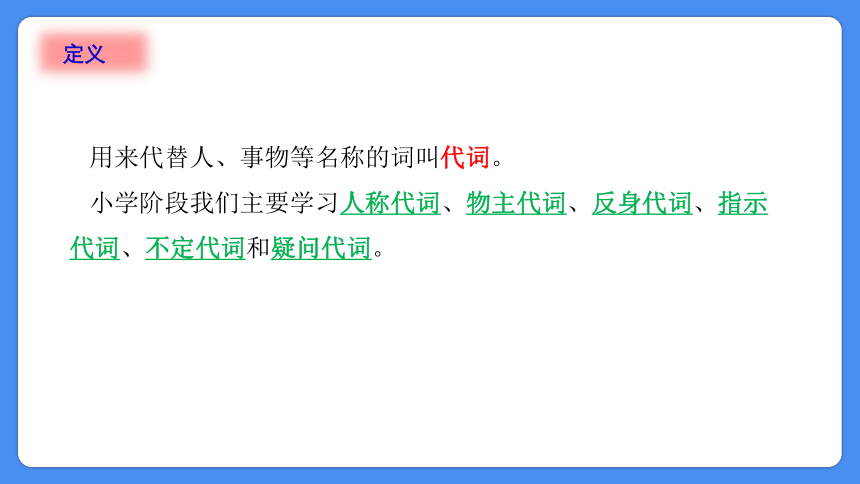
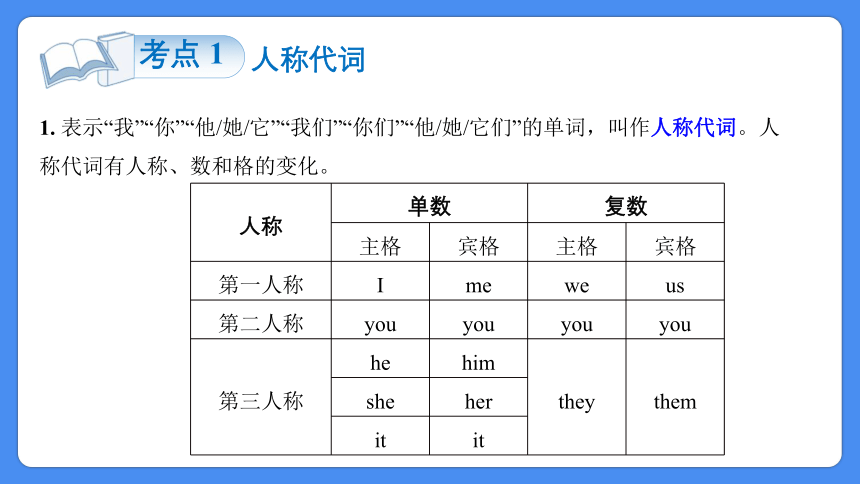
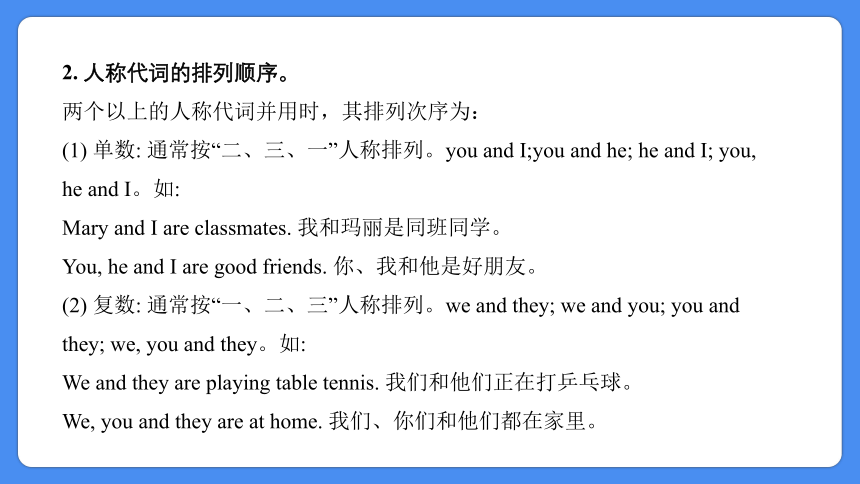
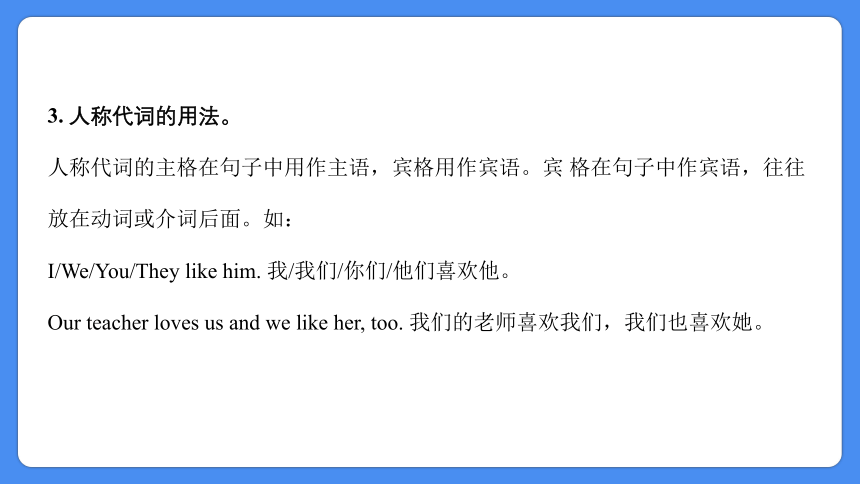
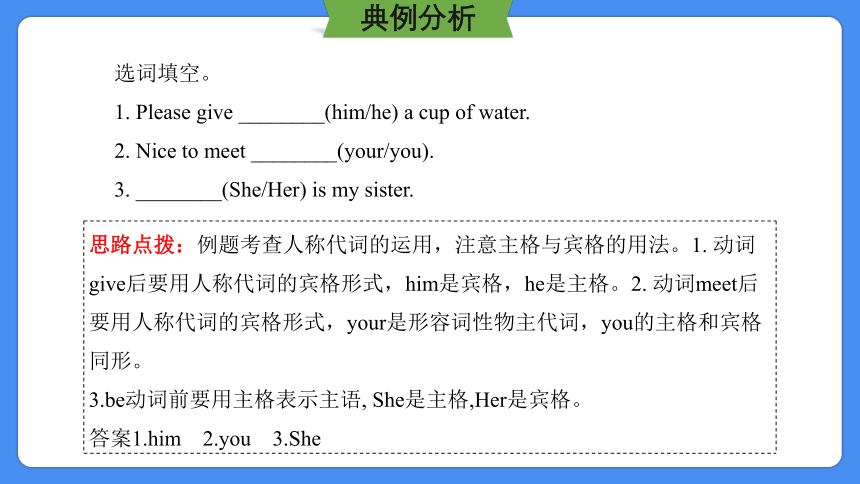
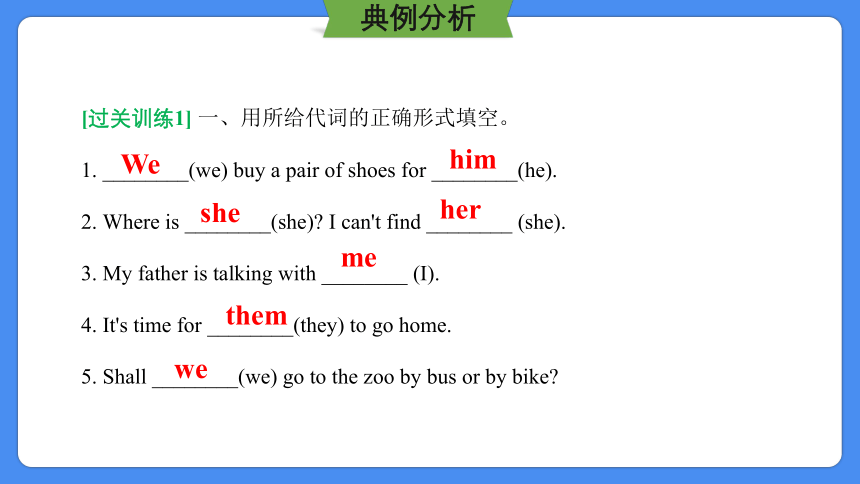
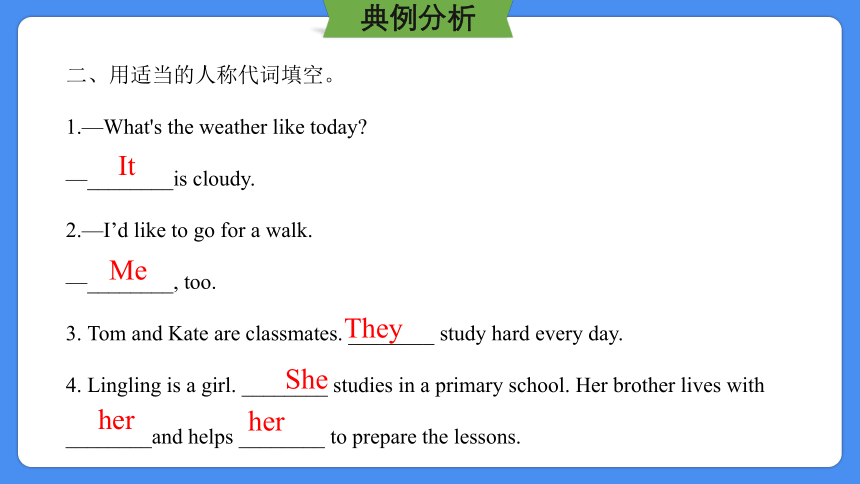
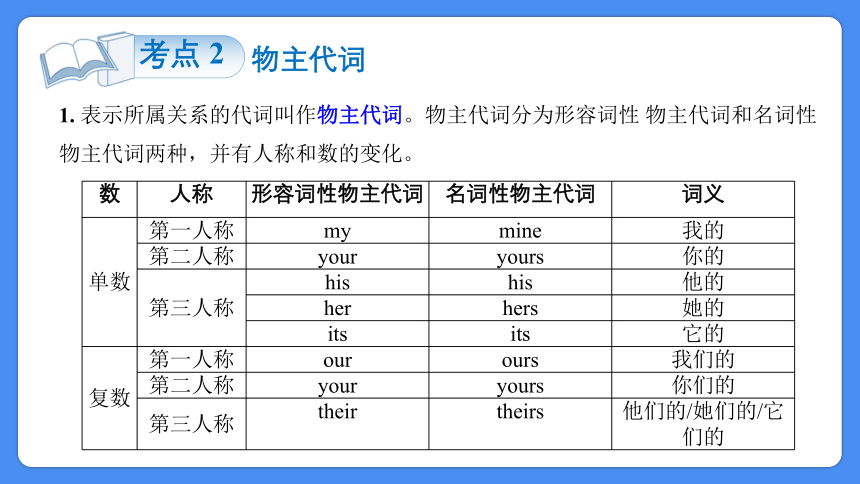
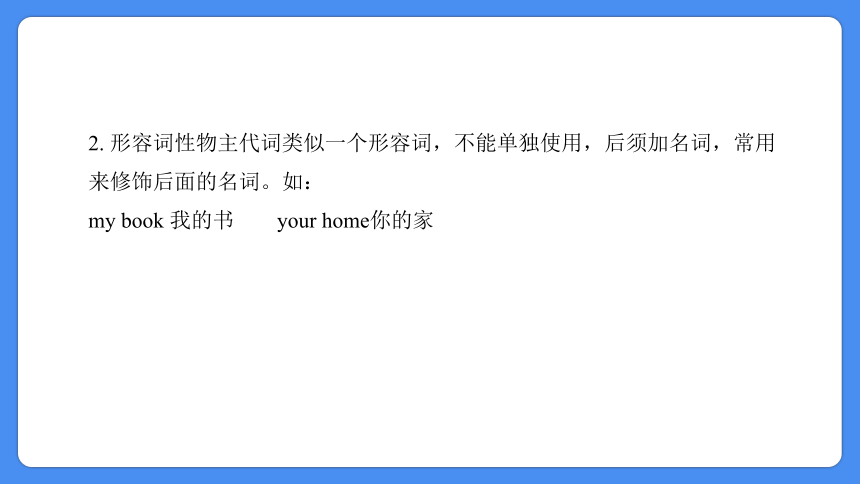
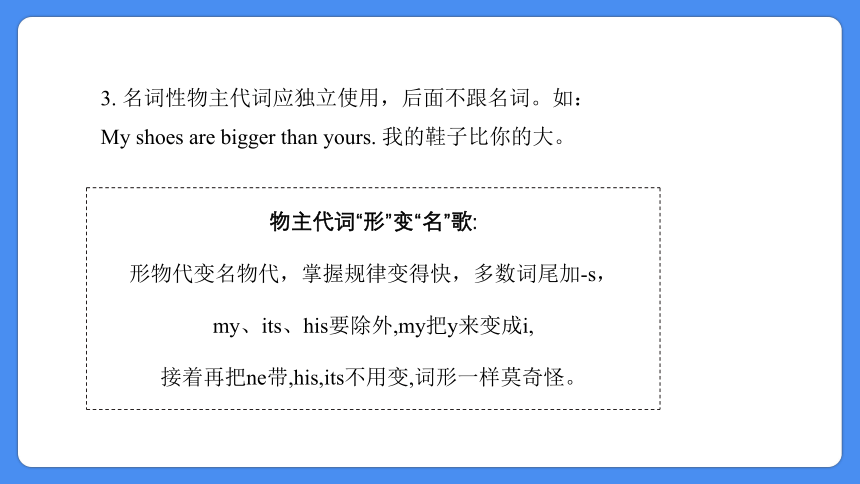
文档简介
(共40张PPT)
第五讲 代词授课人:小升初英语专题复习知识导图
用来代替人、事物等名称的词叫代词。
小学阶段我们主要学习人称代词、物主代词、反身代词、指示代词、不定代词和疑问代词。
定义
人称代词
考点 1
1. 表示“我”“你”“他/她/它”“我们”“你们”“他/她/它们”的单词,叫作人称代词。人称代词有人称、数和格的变化。
人称 单数 复数 主格 宾格 主格 宾格
第一人称 I me we us
第二人称 you you you you
第三人称 he him they them
she her it it 2. 人称代词的排列顺序。
两个以上的人称代词并用时,其排列次序为:
(1) 单数: 通常按“二、三、一”人称排列。you and I;you and he; he and I; you, he and I。如:
Mary and I are classmates. 我和玛丽是同班同学。
You, he and I are good friends. 你、我和他是好朋友。
(2) 复数: 通常按“一、二、三”人称排列。we and they; we and you; you and they; we, you and they。如:
We and they are playing table tennis. 我们和他们正在打乒乓球。
We, you and they are at home. 我们、你们和他们都在家里。
3. 人称代词的用法。
人称代词的主格在句子中用作主语,宾格用作宾语。宾 格在句子中作宾语,往往放在动词或介词后面。如:
I/We/You/They like him. 我/我们/你们/他们喜欢他。
Our teacher loves us and we like her, too. 我们的老师喜欢我们,我们也喜欢她。
典例分析
选词填空。
1. Please give ________(him/he) a cup of water.
2. Nice to meet ________(your/you).
3. ________(She/Her) is my sister.
思路点拨:例题考查人称代词的运用,注意主格与宾格的用法。1. 动词give后要用人称代词的宾格形式,him是宾格,he是主格。2. 动词meet后要用人称代词的宾格形式,your是形容词性物主代词,you的主格和宾格同形。
3.be动词前要用主格表示主语, She是主格,Her是宾格。
答案1.him 2.you 3.She
[过关训练1] 一、用所给代词的正确形式填空。
1. ________(we) buy a pair of shoes for ________(he).
2. Where is ________(she) I can't find ________ (she).
3. My father is talking with ________ (I).
4. It's time for ________(they) to go home.
5. Shall ________(we) go to the zoo by bus or by bike
典例分析
We
him
she
her
me
them
we
二、用适当的人称代词填空。
1.—What's the weather like today
—________is cloudy.
2.—I’d like to go for a walk.
—________, too.
3. Tom and Kate are classmates. ________ study hard every day.
4. Lingling is a girl. ________ studies in a primary school. Her brother lives with ________and helps ________ to prepare the lessons.
典例分析
It
Me
They
She
her
her
物主代词
考点 2
1. 表示所属关系的代词叫作物主代词。物主代词分为形容词性 物主代词和名词性物主代词两种,并有人称和数的变化。
数 人称 形容词性物主代词 名词性物主代词 词义
单数 第一人称 my mine 我的
第二人称 your yours 你的
第三人称 his his 他的
her hers 她的
its its 它的
复数 第一人称 our ours 我们的
第二人称 your yours 你们的
第三人称 their theirs 他们的/她们的/它们的
2. 形容词性物主代词类似一个形容词,不能单独使用,后须加名词,常用来修饰后面的名词。如:
my book 我的书 your home你的家
3. 名词性物主代词应独立使用,后面不跟名词。如:
My shoes are bigger than yours. 我的鞋子比你的大。
物主代词“形”变“名”歌:
形物代变名物代,掌握规律变得快,多数词尾加-s,
my、its、his要除外,my把y来变成i,
接着再把ne带,his,its不用变,词形一样莫奇怪。
典例分析
用所给代词的正确形式填空。
1. ________(she) name is Lucy. Look! Those pens are ________(she).
2.—Are these ________(they) bags
—No, they aren’t ________(their).
思路点拨:例题考查物主代词的运用,物主代词分为形容词性物主代词和名词性物主代词。要完成此题,首先要确定横线上应填哪类物主代词。
1.第一空后有名词name,所以应填形容词性物主代词her。第二空后无名词,横线上应填相当于名词的名词性物主代词hers。
2.由第一空后的bags可知应填形容词性物主代词their。第二空后无名词,应填名词性物主代词theirs,表示theirbags。
答案:1.Herhers 2.their theirs
[过关训练2] 一、单项选择。
( ) 1. That's a cat. ________ name is Mimi.
A. It B. It's C. Its D. Its’
( ) 2. These are ________ books. I'll put ________ in the box.
A. my;them B. I;them C. my;they D. mine;them
典例分析
C
A
( ) 3. How beautiful ________is!
A. she B. her C. hers D. its
( ) 4. Kate and Mike do ________ homework in the evening.
A. one’s B. his C. her D. their
( ) 5. We bought ________ a present, but ________didn’t like it.
A. they;them B. them;they
C. themselves;their D. theirs;they
典例分析
A
D
B
二、(广州) 填写适当的代词补全对话。
Tom: Whose bike is it Is it __1__
Mary: No, it's not __2__. __3__ is red, but this bike is blue.
Tom: Is __4__ Jane’s
Mary: Sorry, I don't know. Maybe it's __5__.
Tom: Jane, is this __6__ bike
Jane: No, it's not __7__. You can ask Bill. Maybe it's __8__.
Tom: Bill, is this bike __9__
Bill: Oh, yes, it's __10__ bike. Thank you very much!
1. ________ 2. ________ 3. ________ 4. ________ 5. ________
6. ________ 7. ________ 8. ________ 9. ________ 10. ________
典例分析
yours
mine
Mine
it
hers
your
mine
his
yours
my
反身代词
考点 3
1. 表示反射或强调的代词叫作反身代词。反身代词可译为“我 (们) 自己、你(们) 自己、他 (们) /她(们) /它(们) 自己”。
人称数 单数 复数
第一人称 myse1f(我自己) ourse1ves(我们自己)
第二人称 yourse1f(你自己) yourse1ves(你们自己)
第三人称 himse1f(他自己) themselves(他们/她们/它们自己)
herse1f(她自己) Itse1f(它自己) 2. 反身代词的作用。
(1) 反身代词表示动作行为反射到行为执行者本身。如:
Enjoy yourself. 好好玩。 Help yourself. 请自便。
They can look after themselves. 他们能照顾自己。
(2) 反身代词常用来加强语气。如:
I open the window by myself. 我自己打开窗户。
反身代词变化歌:
反身代词代自己,懂得规律很好记。
单数人称加-self,复数人称加-selves。
一、二人称都一样,形容词性物主代词后加“自己”。
第三人称不一样,要用宾格加“自己”。
典例分析
单项选择。
( ) 1. Help ________ to some chicken, children.
A. your B. yourself C. yourselves D. themselves
( ) 2. Children can usually dress ________ by the age of five.
A. themselves B. them C. selves D. ones
思路点拨:例题考查反身代词的运用。
1.help oneself to意为“随便吃点”。由于说话的对象children是复数形式,所以横线处应填yourselves。
2.dress oneself意为“自己穿衣服”。因为主语children是复数形式,所以横线处应填themselves。
答案 1.C 2.A
[过关训练3] 一、单项选择。
( ) 1. They look after ________ at home.
A. yourselves B. yourself
C. themselves D. them
( ) 2. Lily was 9 years old. ________ was old enough to go to school ________.
A. She;she B. She;herself
C. Her;herself D. Her;she
( ) 3. Would you go there by ________
A. yourself B. myself
C. himself D. herself
典例分析
C
B
A
二、用所给代词的正确形式填空。
1. He is too young to dress ________(he).
2.—Who taught you English last year
—Nobody taught me. I taught ________(I).
3. Help ________(you) to some meat, Mary.
典例分析
himself
myself
yourself
指示代词
考点 4
1. 指示代词的定义。
表示“这个”“那个”“这些”“那些”等指示概念的代词叫指示代词。
2. 指示代词的分类及用法。
分类 用法 示例
近指 this 指时间或空间上较近的人或事物,指代或修饰可数名词单数。 This is my map.这是我的地图。
these 指时间或空间上较近的人或事物,指代或修饰可数名词复数。 These boys are our friends.这些男孩是我们的朋友。
远指 that 指时间或空间上较远的人或事物,指代或修饰可数名词单数。 That bird is yellow.那只鸟是黄色的。
those 指时间或空间上较远的人或事物,指代或修饰可数名词复数。 Those are trees.那些是树。
3. 使用指示代词的注意事项。
(1) 在回答指示代词作主语的一般疑问句或特殊疑问句时,答语要用it代替 this 或that, 用they代替 these 或 those。
(2) 若名词前有指示代词修饰时,其前就不能再用冠词或形容词性物主代词。
如何将单数句变为复数句:
(1)指示代词的变化:this变these,that变those;
人称代词的变化:Ⅰ变成we,you不发生变化,
he/she/it变成they。
(2)be动词的变化:am/is变成are。
(3)可数名词的变化:单数名词变为复数名词。
如:This is a cat.→These are cats.
He is a child.→They are children.
典例分析
单项选择。
( ) 1. This is my ________, and these are my ________.
A. sisters;parent B. brothers;sisters C. sister;parents D. parent;brother
( ) 2. Mum, ________is my friend, Tom. Tom, ________ is my mother.
A. this;she B. he;this C. this;this D. he;she
思路点拨:例题考查指示代词单复数与相对应的名词单复数情况,以及指示代词在介绍用语中的运用。
1.与主语this相对应的名词应用单数形式,与主语these相对应的名词应用复数形式,故本题选C。
2.介绍某人时常用指示代词而不用人称代词,运用句型“This is…”,故本题选 C。
答案1.C 2.C
[过关训练4]一、单项选择。
( ) 1.________ is my cousin, and ________ are my classmates.
A. This;this B. This;these C. These;these D. That;these
( ) 2. Are ________ your watches over there
A. this B. that C. these D. those
( ) 3.—Is ________Li Ping —Yes, speaking.
A. this B. she C. that D. it
( ) 4.——Is this your friend —________
A. Yes, he is. B. Yes, it is. C. No, it's not. D. Yes,I am.
( ) 5.—What are those —________
A. They are box. B. They are boxes. C. It's a box. D. Yes, they are.
典例分析
B
D
C
A
B
二、按要求完成句子。
1. Is this your pen (作否定回答)
2. Are those Kate's parents (作肯定回答)
3. These are oranges. (对画线部分提问)
4. Is this her dictionary (改为复数句)
5. Those aren't my watches.(改为单数句)
典例分析
No, it isn't.
Yes, they are.
What are these
Are these their dictionaries
That isn't my watch.
不定代词
考点 5
1. 不指明代替任何特定名词或形容词的代词叫不定代词。常见的不定代词如下:
other另一个 others另一些 another另一个;又一个 many许多(用于可数名词) much许多(用于不可数名词) few很少;几乎没有(用于可数名词前) a few几个;一些(用于可数名词前) little很少;几乎没有(用于不可数名词前) a little一些(用于不可数名词前) one一个(泛指一个人或物) some一些 somebody某人someone某人something某事;某物 any一些;任何anybody任何人anyone任何人anything任何事物 no无 nobody没有人 no one无人 nothing没什么 all全体;全部
both两个(都)
none没有人或物(指两个以上)
neither没有人或物(指两个当中)
either任何一个(指两个当中)
each每个
every每一个
everybody每人;大家;人人
everyone每人
everything每一件事物;一切
2. 常见的不定代词的用法辨析。
(1) some和 any。
some常用在肯定句中,any常用在否定句和疑问句中。
(2) one 和 ones。
one可代替上文中出现过的单数可数名词,具有泛指意义,其复数形式为 ones。
(3) all 和 both。
all表示三者或三者以上都,both 表示两者都。
(4) few、a few 和 little、a little。
few 和 little 表示否定含义, 都有“几乎没有”的意思。
few 后面接可数名词,little 后面接不可数名词。
a few 和a little 表示肯定含义, 都有“少数; 少量”的意思。
a few后面接可数名词, a little 后面接不可数名词。
(5) many 和 much。
many 和 much 都有“许多; 大量”的意思。many 只代替或修饰可数名词复数,much 只代替或修饰不可数名词。
典例分析
按要求完成下列各题。
1.用 some或any填空。
—Is there ________ water in the cup
—Yes, there is ________ water in the cup.
2.单项选择。
( ) There is ________ milk in the glass.
A. many B. little C. few D. a few
思路点拨:例题考查不定代词的用法。1.some一般用于肯定句中,any一般用于否定句或疑问句中。第一空所在的句子为一般疑问句,用any。第二空所在的句子为肯定句,用some。2.milk是不可数名词,many、few、afew均用于可数名词前,little用于不可数名词前,故选B。
答案1.any some 2.B
[过关训练5]一、单项选择。
( ) 1.—Would you like some tea
—Yes, just ________.
A. a few B. few C. a little D. little bit
( ) 2. Would you like ________ for supper
A. something Chinese B. Chinese something
C. anything Chinese D. Chinese anything
典例分析
C
A
( ) 3.—Would you like some tea or coffee
—________. Thanks, I’ve had enough.
A. Either B. Neither C. Some D. Both
( ) 4. ________ of the teachers are OK in our school.
A. Every B. Each C. Either D. All
( ) 5. The old man kept one black dog and two white ________.
A. one B. ones C. those D. one’s
典例分析
B
D
B
二、选出错误的选项,并在横线上改正。
( ) 1. There are a little students in the classroom. ________
A B C
( ) 2. I don't have some apples. ________
A B C
( ) 3. There is many tea in the cup. ________
A B C
典例分析
B
C/A
B
a few
any/删去
much
疑问代词
考点 6
用在疑问句中,用来询问“何人”“何物”“什么”的代词叫疑问代词。
疑问代词 词义 说明
who 谁(主格) 作主语,用来指人。
whom 谁(宾格) 作宾语,用来指人。
whose 谁的 用来指所属关系,如果作定语,一般后接名词。
which 哪一个 用来指人或事物,在一定范围限制之内进行选择。
what 什么 通常指事物,有时也可用来问人的身份。
典例分析
按要求完成下列各题。
1.单项选择。
( ) —________ is that girl —She is my sister.
A. Who B. What C. Where D. How
2.用适当的疑问代词填空。
(1) —________ rabbits are these —They are Tom’s.
(2) —________ colour are the shoes —They are white.
思路点拨:
1.由答语“She is my sister.”可知是询问人物是谁,Who用来指人,故选A。
2.(1)疑问代词后紧接名词rabbits,且答语中有单词Tom’s,故应填疑问代词Whose。(2)由答语中的white可知问句中问的是鞋的颜色,用what colour提问,故应填What。
答案1.A 2.(1)Whose (2)What
[过关训练6]一、用合适的疑问代词填空。
1.—________ is this
—It's a map.
2.—________ does your mother do
—She is a cleaner.
3.—________ one do you like
—I like the blue one.
4.—________ is your sister talking to
—She's talking to her teacher.
5.—________ crayons are these
—They're Mike's.
典例分析
What
What
Which
Who/Whom
Whose
典例分析
B
C
A
E
D
二、给下列问句选出正确的应答语。
( ) 1. Why does Kitty like the oil painting
( ) 2. Which one do you like, Joe
( ) 3. How much do you weigh
( ) 4. What do you want to make, Jill
( ) 5. What do you often do after school
A. 40 kilograms.
B. Because she likes the colours.
C. I like the one on the right.
D. I often play football with my classmates.
E. I want to make a crown.
授课人:Thank you!
第五讲 代词授课人:小升初英语专题复习知识导图
用来代替人、事物等名称的词叫代词。
小学阶段我们主要学习人称代词、物主代词、反身代词、指示代词、不定代词和疑问代词。
定义
人称代词
考点 1
1. 表示“我”“你”“他/她/它”“我们”“你们”“他/她/它们”的单词,叫作人称代词。人称代词有人称、数和格的变化。
人称 单数 复数 主格 宾格 主格 宾格
第一人称 I me we us
第二人称 you you you you
第三人称 he him they them
she her it it 2. 人称代词的排列顺序。
两个以上的人称代词并用时,其排列次序为:
(1) 单数: 通常按“二、三、一”人称排列。you and I;you and he; he and I; you, he and I。如:
Mary and I are classmates. 我和玛丽是同班同学。
You, he and I are good friends. 你、我和他是好朋友。
(2) 复数: 通常按“一、二、三”人称排列。we and they; we and you; you and they; we, you and they。如:
We and they are playing table tennis. 我们和他们正在打乒乓球。
We, you and they are at home. 我们、你们和他们都在家里。
3. 人称代词的用法。
人称代词的主格在句子中用作主语,宾格用作宾语。宾 格在句子中作宾语,往往放在动词或介词后面。如:
I/We/You/They like him. 我/我们/你们/他们喜欢他。
Our teacher loves us and we like her, too. 我们的老师喜欢我们,我们也喜欢她。
典例分析
选词填空。
1. Please give ________(him/he) a cup of water.
2. Nice to meet ________(your/you).
3. ________(She/Her) is my sister.
思路点拨:例题考查人称代词的运用,注意主格与宾格的用法。1. 动词give后要用人称代词的宾格形式,him是宾格,he是主格。2. 动词meet后要用人称代词的宾格形式,your是形容词性物主代词,you的主格和宾格同形。
3.be动词前要用主格表示主语, She是主格,Her是宾格。
答案1.him 2.you 3.She
[过关训练1] 一、用所给代词的正确形式填空。
1. ________(we) buy a pair of shoes for ________(he).
2. Where is ________(she) I can't find ________ (she).
3. My father is talking with ________ (I).
4. It's time for ________(they) to go home.
5. Shall ________(we) go to the zoo by bus or by bike
典例分析
We
him
she
her
me
them
we
二、用适当的人称代词填空。
1.—What's the weather like today
—________is cloudy.
2.—I’d like to go for a walk.
—________, too.
3. Tom and Kate are classmates. ________ study hard every day.
4. Lingling is a girl. ________ studies in a primary school. Her brother lives with ________and helps ________ to prepare the lessons.
典例分析
It
Me
They
She
her
her
物主代词
考点 2
1. 表示所属关系的代词叫作物主代词。物主代词分为形容词性 物主代词和名词性物主代词两种,并有人称和数的变化。
数 人称 形容词性物主代词 名词性物主代词 词义
单数 第一人称 my mine 我的
第二人称 your yours 你的
第三人称 his his 他的
her hers 她的
its its 它的
复数 第一人称 our ours 我们的
第二人称 your yours 你们的
第三人称 their theirs 他们的/她们的/它们的
2. 形容词性物主代词类似一个形容词,不能单独使用,后须加名词,常用来修饰后面的名词。如:
my book 我的书 your home你的家
3. 名词性物主代词应独立使用,后面不跟名词。如:
My shoes are bigger than yours. 我的鞋子比你的大。
物主代词“形”变“名”歌:
形物代变名物代,掌握规律变得快,多数词尾加-s,
my、its、his要除外,my把y来变成i,
接着再把ne带,his,its不用变,词形一样莫奇怪。
典例分析
用所给代词的正确形式填空。
1. ________(she) name is Lucy. Look! Those pens are ________(she).
2.—Are these ________(they) bags
—No, they aren’t ________(their).
思路点拨:例题考查物主代词的运用,物主代词分为形容词性物主代词和名词性物主代词。要完成此题,首先要确定横线上应填哪类物主代词。
1.第一空后有名词name,所以应填形容词性物主代词her。第二空后无名词,横线上应填相当于名词的名词性物主代词hers。
2.由第一空后的bags可知应填形容词性物主代词their。第二空后无名词,应填名词性物主代词theirs,表示theirbags。
答案:1.Herhers 2.their theirs
[过关训练2] 一、单项选择。
( ) 1. That's a cat. ________ name is Mimi.
A. It B. It's C. Its D. Its’
( ) 2. These are ________ books. I'll put ________ in the box.
A. my;them B. I;them C. my;they D. mine;them
典例分析
C
A
( ) 3. How beautiful ________is!
A. she B. her C. hers D. its
( ) 4. Kate and Mike do ________ homework in the evening.
A. one’s B. his C. her D. their
( ) 5. We bought ________ a present, but ________didn’t like it.
A. they;them B. them;they
C. themselves;their D. theirs;they
典例分析
A
D
B
二、(广州) 填写适当的代词补全对话。
Tom: Whose bike is it Is it __1__
Mary: No, it's not __2__. __3__ is red, but this bike is blue.
Tom: Is __4__ Jane’s
Mary: Sorry, I don't know. Maybe it's __5__.
Tom: Jane, is this __6__ bike
Jane: No, it's not __7__. You can ask Bill. Maybe it's __8__.
Tom: Bill, is this bike __9__
Bill: Oh, yes, it's __10__ bike. Thank you very much!
1. ________ 2. ________ 3. ________ 4. ________ 5. ________
6. ________ 7. ________ 8. ________ 9. ________ 10. ________
典例分析
yours
mine
Mine
it
hers
your
mine
his
yours
my
反身代词
考点 3
1. 表示反射或强调的代词叫作反身代词。反身代词可译为“我 (们) 自己、你(们) 自己、他 (们) /她(们) /它(们) 自己”。
人称数 单数 复数
第一人称 myse1f(我自己) ourse1ves(我们自己)
第二人称 yourse1f(你自己) yourse1ves(你们自己)
第三人称 himse1f(他自己) themselves(他们/她们/它们自己)
herse1f(她自己) Itse1f(它自己) 2. 反身代词的作用。
(1) 反身代词表示动作行为反射到行为执行者本身。如:
Enjoy yourself. 好好玩。 Help yourself. 请自便。
They can look after themselves. 他们能照顾自己。
(2) 反身代词常用来加强语气。如:
I open the window by myself. 我自己打开窗户。
反身代词变化歌:
反身代词代自己,懂得规律很好记。
单数人称加-self,复数人称加-selves。
一、二人称都一样,形容词性物主代词后加“自己”。
第三人称不一样,要用宾格加“自己”。
典例分析
单项选择。
( ) 1. Help ________ to some chicken, children.
A. your B. yourself C. yourselves D. themselves
( ) 2. Children can usually dress ________ by the age of five.
A. themselves B. them C. selves D. ones
思路点拨:例题考查反身代词的运用。
1.help oneself to意为“随便吃点”。由于说话的对象children是复数形式,所以横线处应填yourselves。
2.dress oneself意为“自己穿衣服”。因为主语children是复数形式,所以横线处应填themselves。
答案 1.C 2.A
[过关训练3] 一、单项选择。
( ) 1. They look after ________ at home.
A. yourselves B. yourself
C. themselves D. them
( ) 2. Lily was 9 years old. ________ was old enough to go to school ________.
A. She;she B. She;herself
C. Her;herself D. Her;she
( ) 3. Would you go there by ________
A. yourself B. myself
C. himself D. herself
典例分析
C
B
A
二、用所给代词的正确形式填空。
1. He is too young to dress ________(he).
2.—Who taught you English last year
—Nobody taught me. I taught ________(I).
3. Help ________(you) to some meat, Mary.
典例分析
himself
myself
yourself
指示代词
考点 4
1. 指示代词的定义。
表示“这个”“那个”“这些”“那些”等指示概念的代词叫指示代词。
2. 指示代词的分类及用法。
分类 用法 示例
近指 this 指时间或空间上较近的人或事物,指代或修饰可数名词单数。 This is my map.这是我的地图。
these 指时间或空间上较近的人或事物,指代或修饰可数名词复数。 These boys are our friends.这些男孩是我们的朋友。
远指 that 指时间或空间上较远的人或事物,指代或修饰可数名词单数。 That bird is yellow.那只鸟是黄色的。
those 指时间或空间上较远的人或事物,指代或修饰可数名词复数。 Those are trees.那些是树。
3. 使用指示代词的注意事项。
(1) 在回答指示代词作主语的一般疑问句或特殊疑问句时,答语要用it代替 this 或that, 用they代替 these 或 those。
(2) 若名词前有指示代词修饰时,其前就不能再用冠词或形容词性物主代词。
如何将单数句变为复数句:
(1)指示代词的变化:this变these,that变those;
人称代词的变化:Ⅰ变成we,you不发生变化,
he/she/it变成they。
(2)be动词的变化:am/is变成are。
(3)可数名词的变化:单数名词变为复数名词。
如:This is a cat.→These are cats.
He is a child.→They are children.
典例分析
单项选择。
( ) 1. This is my ________, and these are my ________.
A. sisters;parent B. brothers;sisters C. sister;parents D. parent;brother
( ) 2. Mum, ________is my friend, Tom. Tom, ________ is my mother.
A. this;she B. he;this C. this;this D. he;she
思路点拨:例题考查指示代词单复数与相对应的名词单复数情况,以及指示代词在介绍用语中的运用。
1.与主语this相对应的名词应用单数形式,与主语these相对应的名词应用复数形式,故本题选C。
2.介绍某人时常用指示代词而不用人称代词,运用句型“This is…”,故本题选 C。
答案1.C 2.C
[过关训练4]一、单项选择。
( ) 1.________ is my cousin, and ________ are my classmates.
A. This;this B. This;these C. These;these D. That;these
( ) 2. Are ________ your watches over there
A. this B. that C. these D. those
( ) 3.—Is ________Li Ping —Yes, speaking.
A. this B. she C. that D. it
( ) 4.——Is this your friend —________
A. Yes, he is. B. Yes, it is. C. No, it's not. D. Yes,I am.
( ) 5.—What are those —________
A. They are box. B. They are boxes. C. It's a box. D. Yes, they are.
典例分析
B
D
C
A
B
二、按要求完成句子。
1. Is this your pen (作否定回答)
2. Are those Kate's parents (作肯定回答)
3. These are oranges. (对画线部分提问)
4. Is this her dictionary (改为复数句)
5. Those aren't my watches.(改为单数句)
典例分析
No, it isn't.
Yes, they are.
What are these
Are these their dictionaries
That isn't my watch.
不定代词
考点 5
1. 不指明代替任何特定名词或形容词的代词叫不定代词。常见的不定代词如下:
other另一个 others另一些 another另一个;又一个 many许多(用于可数名词) much许多(用于不可数名词) few很少;几乎没有(用于可数名词前) a few几个;一些(用于可数名词前) little很少;几乎没有(用于不可数名词前) a little一些(用于不可数名词前) one一个(泛指一个人或物) some一些 somebody某人someone某人something某事;某物 any一些;任何anybody任何人anyone任何人anything任何事物 no无 nobody没有人 no one无人 nothing没什么 all全体;全部
both两个(都)
none没有人或物(指两个以上)
neither没有人或物(指两个当中)
either任何一个(指两个当中)
each每个
every每一个
everybody每人;大家;人人
everyone每人
everything每一件事物;一切
2. 常见的不定代词的用法辨析。
(1) some和 any。
some常用在肯定句中,any常用在否定句和疑问句中。
(2) one 和 ones。
one可代替上文中出现过的单数可数名词,具有泛指意义,其复数形式为 ones。
(3) all 和 both。
all表示三者或三者以上都,both 表示两者都。
(4) few、a few 和 little、a little。
few 和 little 表示否定含义, 都有“几乎没有”的意思。
few 后面接可数名词,little 后面接不可数名词。
a few 和a little 表示肯定含义, 都有“少数; 少量”的意思。
a few后面接可数名词, a little 后面接不可数名词。
(5) many 和 much。
many 和 much 都有“许多; 大量”的意思。many 只代替或修饰可数名词复数,much 只代替或修饰不可数名词。
典例分析
按要求完成下列各题。
1.用 some或any填空。
—Is there ________ water in the cup
—Yes, there is ________ water in the cup.
2.单项选择。
( ) There is ________ milk in the glass.
A. many B. little C. few D. a few
思路点拨:例题考查不定代词的用法。1.some一般用于肯定句中,any一般用于否定句或疑问句中。第一空所在的句子为一般疑问句,用any。第二空所在的句子为肯定句,用some。2.milk是不可数名词,many、few、afew均用于可数名词前,little用于不可数名词前,故选B。
答案1.any some 2.B
[过关训练5]一、单项选择。
( ) 1.—Would you like some tea
—Yes, just ________.
A. a few B. few C. a little D. little bit
( ) 2. Would you like ________ for supper
A. something Chinese B. Chinese something
C. anything Chinese D. Chinese anything
典例分析
C
A
( ) 3.—Would you like some tea or coffee
—________. Thanks, I’ve had enough.
A. Either B. Neither C. Some D. Both
( ) 4. ________ of the teachers are OK in our school.
A. Every B. Each C. Either D. All
( ) 5. The old man kept one black dog and two white ________.
A. one B. ones C. those D. one’s
典例分析
B
D
B
二、选出错误的选项,并在横线上改正。
( ) 1. There are a little students in the classroom. ________
A B C
( ) 2. I don't have some apples. ________
A B C
( ) 3. There is many tea in the cup. ________
A B C
典例分析
B
C/A
B
a few
any/删去
much
疑问代词
考点 6
用在疑问句中,用来询问“何人”“何物”“什么”的代词叫疑问代词。
疑问代词 词义 说明
who 谁(主格) 作主语,用来指人。
whom 谁(宾格) 作宾语,用来指人。
whose 谁的 用来指所属关系,如果作定语,一般后接名词。
which 哪一个 用来指人或事物,在一定范围限制之内进行选择。
what 什么 通常指事物,有时也可用来问人的身份。
典例分析
按要求完成下列各题。
1.单项选择。
( ) —________ is that girl —She is my sister.
A. Who B. What C. Where D. How
2.用适当的疑问代词填空。
(1) —________ rabbits are these —They are Tom’s.
(2) —________ colour are the shoes —They are white.
思路点拨:
1.由答语“She is my sister.”可知是询问人物是谁,Who用来指人,故选A。
2.(1)疑问代词后紧接名词rabbits,且答语中有单词Tom’s,故应填疑问代词Whose。(2)由答语中的white可知问句中问的是鞋的颜色,用what colour提问,故应填What。
答案1.A 2.(1)Whose (2)What
[过关训练6]一、用合适的疑问代词填空。
1.—________ is this
—It's a map.
2.—________ does your mother do
—She is a cleaner.
3.—________ one do you like
—I like the blue one.
4.—________ is your sister talking to
—She's talking to her teacher.
5.—________ crayons are these
—They're Mike's.
典例分析
What
What
Which
Who/Whom
Whose
典例分析
B
C
A
E
D
二、给下列问句选出正确的应答语。
( ) 1. Why does Kitty like the oil painting
( ) 2. Which one do you like, Joe
( ) 3. How much do you weigh
( ) 4. What do you want to make, Jill
( ) 5. What do you often do after school
A. 40 kilograms.
B. Because she likes the colours.
C. I like the one on the right.
D. I often play football with my classmates.
E. I want to make a crown.
授课人:Thank you!
